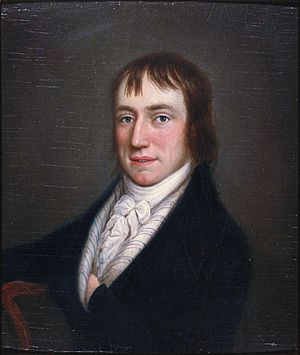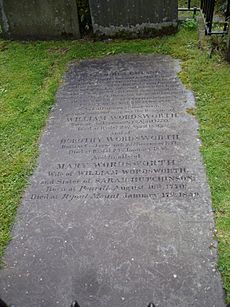William Wordsworth facts for kids
Quick facts for kids
William Wordsworth
|
|
|---|---|
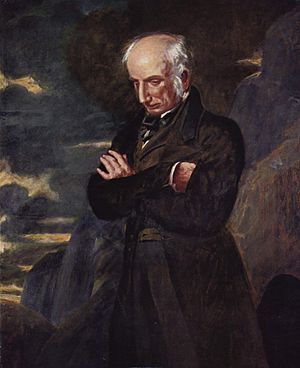
Wordsworth on Helvellyn by Benjamin Haydon (National Portrait Gallery).
|
|
| Poet Laureate of the United Kingdom | |
| In office 6 April 1843 – 23 April 1850 |
|
| Monarch | Victoria |
| Preceded by | Robert Southey |
| Succeeded by | Alfred, Lord Tennyson |
| Personal details | |
| Born | 7 April 1770 Cockermouth, Cumberland, England |
| Died | 23 April 1850 (aged 80) Rydal, Westmorland, England |
| Spouse | Mary Hutchinson (1802–1850; his death) |
| Children | Dora Wordsworth |
| Relatives |
|
| Alma mater | St John's College, Cambridge |
| Occupation | Poet |
| Signature | |
William Wordsworth (born April 7, 1770 – died April 23, 1850) was a famous English Romantic poet. He helped start the Romantic Age in English literature. He did this with his friend Samuel Taylor Coleridge when they published their book Lyrical Ballads in 1798.
Many people think Wordsworth's greatest work is The Prelude. This long poem tells the story of his early life. He kept working on it and changing it over many years. His wife published it after he died, and it became very famous.
Wordsworth was also the Poet Laureate from 1843 until he passed away in 1850. This means he was the official poet for the British royal family.
Contents
- William Wordsworth's Early Life and Education
- Wordsworth's Early Career and Famous Works
- Life in the Lake District and the "Lake Poets"
- Wordsworth's Marriage and Family Life
- Later Career and Important Poems
- Wordsworth's Beliefs and Poetic Style
- Honors and Poet Laureate Role
- Wordsworth's Death and Legacy
- Major Works by William Wordsworth
- See also
William Wordsworth's Early Life and Education
William Wordsworth was born on April 7, 1770, in Cockermouth, England. This area is now part of the beautiful Lake District. He was the second of five children. His sister, Dorothy Wordsworth, was born a year later. They were very close throughout their lives.
William's father, John Wordsworth, was a lawyer. He was often away for work. But he encouraged William to read a lot. William loved reading books from his father's library. He also memorized parts of poems by famous writers like Milton and Shakespeare.
William went to a small school in Cockermouth first. Then he went to a school in Penrith. There, he learned about the Bible and other important texts. He also met Mary Hutchinson there, who later became his wife.
After his mother died in 1778, William went to Hawkshead Grammar School. His sister Dorothy went to live with relatives. They did not see each other for nine years.
In 1787, Wordsworth published his first poem in a magazine. That same year, he started college at St John's College, Cambridge. He often spent his holidays walking and exploring beautiful landscapes. In 1790, he even went on a walking tour of Europe, seeing the Alps and parts of France, Switzerland, and Italy.
Wordsworth's Time in France and His Daughter
In 1791, Wordsworth visited Revolutionary France. He was excited by the new ideas there. While in France, he met Annette Vallon. They had a daughter named Caroline in 1792.
Because of money problems and growing tension between Britain and France, Wordsworth had to return to England alone. He supported Annette and Caroline as much as he could from afar. The war between Britain and France made it hard for him to visit them for many years.
In 1802, when travel to France was possible again, Wordsworth and his sister Dorothy visited Annette and Caroline. This visit was to tell Annette that William was going to marry Mary Hutchinson. After this trip, he wrote a poem called "It is a beauteous evening, calm and free". It was about a walk with his daughter Caroline, whom he had not seen before.
Wordsworth's Early Career and Famous Works
In 1793, Wordsworth published his first poetry collections. These were called An Evening Walk and Descriptive Sketches. In 1795, he received some money that allowed him to focus on being a poet.
That same year, he met Samuel Taylor Coleridge. They quickly became close friends. For two years, William and Dorothy lived in Dorset. They enjoyed long walks in the countryside.
In 1797, they moved closer to Coleridge in Somerset. Together, Wordsworth and Coleridge created Lyrical Ballads (1798). This book was very important for the English Romantic movement. It included famous poems like Wordsworth's "Tintern Abbey" and Coleridge's "The Rime of the Ancient Mariner".
The second edition of Lyrical Ballads came out in 1800. This time, only Wordsworth was listed as the author. He added a special introduction to the poems. In this introduction, he talked about a new kind of poetry. He wanted poetry to use everyday language, not fancy words. He also famously said that poetry is "the spontaneous overflow of powerful feelings."
The Borderers: Wordsworth's Only Play
Between 1795 and 1797, Wordsworth wrote his only play, The Borderers. It was a sad play set in the time of King Henry III. It was about conflicts between English and Scottish people. He tried to get the play performed, but it was rejected. The play was not published until 1842, after he made many changes to it.
Life in the Lake District and the "Lake Poets"
In 1798, Wordsworth, Dorothy, and Coleridge traveled to Germany. While there, Wordsworth felt very homesick. During the cold winter of 1798–99, Wordsworth lived with Dorothy in Goslar. He started working on his long poem, The Prelude, during this time. He also wrote other famous poems, like "The Lucy poems".
In 1799, Wordsworth and Dorothy returned to England. They settled at Dove Cottage in Grasmere, in the Lake District. Another poet, Robert Southey, lived nearby. Wordsworth, Coleridge, and Southey became known as the "Lake Poets". Many of Wordsworth's poems from this time were about themes like death, sadness, and being separated from loved ones.
Wordsworth's Marriage and Family Life
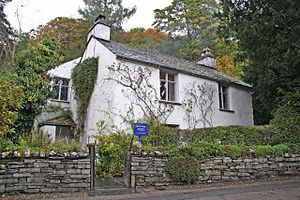
In 1802, Wordsworth received money that allowed him to get married. On October 4, after visiting Annette in France, he married his childhood friend Mary Hutchinson. Dorothy continued to live with them and became very close to Mary.
William and Mary had five children. Sadly, three of them died before their parents. Their children were:
- John Wordsworth (1803–1875)
- Dora Wordsworth (1804–1847)
- Thomas Wordsworth (1806–1812)
- Catherine Wordsworth (1808–1812)
- William "Willy" Wordsworth (1810–1883)
Later Career and Important Poems
Wordsworth had planned to write a very long philosophical poem called The Recluse. In 1798, he started writing an autobiographical poem, which he called "the poem to Coleridge." He planned for it to be part of The Recluse. In 1804, he decided to make this autobiographical work a prologue instead. He finished it in 1805, but he did not want to publish such a personal work until The Recluse was finished. This poem was later published as The Prelude.
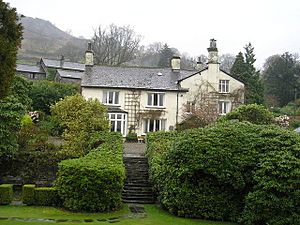
In 1807, Wordsworth published Poems, in Two Volumes. This collection included famous poems like "Ode: Intimations of Immortality from Recollections of Early Childhood" and "I Wandered Lonely as a Cloud" (also known as "Daffodils"). He hoped this new book would make him more famous, but it received a mixed reaction at first.
In 1810, Wordsworth and Coleridge had a disagreement. In 1812, Wordsworth's son Thomas died, and his daughter Catherine died six months later. These losses were very hard for him. The next year, he got a job as a Distributor of Stamps, which gave him a steady income. In 1813, he and his family moved to Rydal Mount, where he lived for the rest of his life.
The Excursion and Views on Nature
In 1814, Wordsworth published The Excursion. This was meant to be the second part of his big work, The Recluse, but he never finished the first or third parts. In The Excursion, he wrote some of his most famous lines about how the human mind and nature are connected:
... my voice proclaims
How exquisitely the individual Mind
(And the progressive powers perhaps no less
Of the whole species) to the external World
Is fitted:—and how exquisitely, too—
Theme this but little heard of among Men,
The external World is fitted to the Mind;
And the creation (by no lower name
Can it be called) which they with blended might
Accomplish ...
By 1820, Wordsworth's earlier poems were becoming more popular. He started to gain more success. After his friend William Green died in 1823, Wordsworth and Coleridge became friends again. They even toured the Rhineland together in 1828. Sadly, many of his friends and family members passed away in his later years, including Dorothy who became ill. However, many young poets and admirers came to visit him.
Wordsworth's Beliefs and Poetic Style
Wordsworth's early political ideas were quite strong, but he always remained true to his religious beliefs. He was a strong supporter of the Church of England. This can be seen in his poems like Ecclesiastical Sketches (1822).
What Was Wordsworth's Poetic Philosophy?
Wordsworth wanted his poetry to connect with the basic feelings of the human heart. He chose to use language that common people used every day. He believed that poetry should be like a conversation. He wanted his poems to help people feel connected to each other and to society.
For example, in his poem "Farewell," he shows how he and his sister share the same feelings: "We leave you here in solitude to dwell/ With these our latest gifts of tender thought; Thou, like the morning, in thy saffron coat,/ Bright gowan, and marsh-marigold, farewell!" (Lines 19-22).
His "Preface to Lyrical Ballads" also explains why he wrote poetry and what he hoped it would achieve for humanity. He wanted his poems to serve the purpose of bringing people together.
Honors and Poet Laureate Role
In his later years, Wordsworth was a respected figure. In 1838, he received an honorary degree from the University of Durham. The next year, he received another from the University of Oxford. There, he was praised as the "poet of humanity." In 1842, the government gave him a yearly payment, which made him financially secure.
After Robert Southey died in 1843, Wordsworth became the Poet Laureate. He first said he was too old for the job. But the Prime Minister, Robert Peel, promised him that he would not have to write any official poems. So, Wordsworth became the only Poet Laureate who did not write official verses.
The sudden death of his daughter Dora in 1847 was very hard for him. He became very sad and stopped writing new poems.
Wordsworth's Death and Legacy
William Wordsworth died at his home, Rydal Mount, on April 23, 1850. He was buried at St Oswald's Church, Grasmere. A few months after his death, his wife Mary published his long autobiographical poem, The Prelude. At first, people were not very interested in it. But over time, it became known as his greatest work.
In April 2020, the Royal Mail released a series of postage stamps to celebrate 250 years since Wordsworth's birth. The stamps featured Wordsworth and other major British Romantic poets.
Major Works by William Wordsworth
- Lyrical Ballads, with a Few Other Poems (1798)
- "Simon Lee"
- "We are Seven"
- "Lines Written in Early Spring"
- "Expostulation and Reply"
- "The Tables Turned"
- "The Thorn"
- "Lines Composed A Few Miles above Tintern Abbey"
- Lyrical Ballads, with Other Poems (1800)
- Preface to the Lyrical Ballads
- "Strange fits of passion have I known"
- "She Dwelt among the Untrodden Ways"
- "Three years she grew"
- "A Slumber Did my Spirit Seal"
- "I travelled among unknown men"
- "Lucy Gray"
- "The Two April Mornings"
- "Nutting"
- "The Ruined Cottage"
- "Michael"
- "The Kitten at Play"
- Poems, in Two Volumes (1807)
- "Resolution and Independence"
- "I Wandered Lonely as a Cloud" Also known as "Daffodils"
- "My Heart Leaps Up"
- "Ode: Intimations of Immortality"
- "Ode to Duty"
- "The Solitary Reaper"
- "Elegiac Stanzas"
- "Composed upon Westminster Bridge, September 3, 1802"
- "London, 1802"
- "The World Is Too Much with Us"
- "French Revolution" (1810)
- Guide to the Lakes (1810)
- "To the Cuckoo"
- The Excursion (1814)
- Laodamia (1815, 1845)
- The White Doe of Rylstone (1815)
- Peter Bell (1819)
- Ecclesiastical Sonnets (1822)
- The Prelude (1850)
See also
 In Spanish: William Wordsworth para niños
In Spanish: William Wordsworth para niños


